The half cent is the smallest denomination of United States coin ever minted. First authorized by the Coinage Act of 1792 on April 2, 1792, the coin was produced in the United States from 1793 to 1857. The half-cent piece was made of 100% copper and was valued at five milles, or one two-hundredth of a dollar. It was slightly smaller than a modern U.S. quarter with diameters 22 mm (1793), 23.5 mm (1794–1836) and 23 mm (1840–1857). Coinage was discontinued by the Coinage Act of February 21, 1857. They were all produced at the Philadelphia Mint. At the time of their discontinuation, the half cent had the buying power of a dime in today's economic climate.
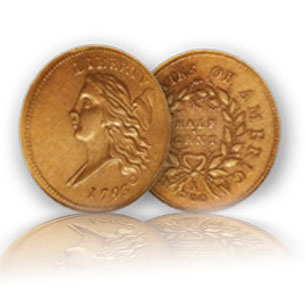
This is a one-year type coin that shows Liberty personified as a female figure facing left that has a Phrygian, or liberty, cap on a pole that extends behind her head. All coins produced were to have edge lettering that stated "Two Hundred for a Dollar." The design is very similar to a commemorative medal that was issued in France celebrating American independence. Approximately 35,000 coins were minted and given the demand for them at the time; most are in well circulated condition.
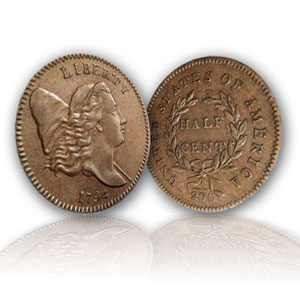
The Liberty Cap half cent is our nation’s second type of half cent. The first, the 1793 Flowing Hair half cent, was struck for one year only. The Liberty Cap half cent was introduced in 1794 so as to fall in line with the Liberty Cap large cent already in circulation since late 1793. Actually, the 1793 Flowing Hair half cent is ALSO a Liberty Cap half cent— but on the Flowing Hair half cent, Miss Liberty faces left and has a somewhat different styled bust, in addition to having its own designer, Henry Voigt.
There are actually two designers credited with the Liberty Cap half cent design: Robert Scot is responsible for the 1794 type, while John Smith Gardiner is credited with the 1795-97 type. Not that the basic designs differ between the 1794 and the 1795-97: both feature a bust of Miss Liberty on the obverse, facing right and flanked by a Liberty Cap on a pole; on the reverse are the words, “Half Cent” within a rather thin wreath.
Some experts surmise that production of the Liberty Cap half cent didn’t actually cease in 1797, as the official records show -—but rather continued on through 1798 and 1799, though recorded under 1797 mintages. There is no definite proof of this however. Whatever the case, the Liberty Cap half cent is one of only a few strictly 18th century U.S. Mint coin types. The United States would start over with a new type of half cent, the Draped Bust type, in 1800.
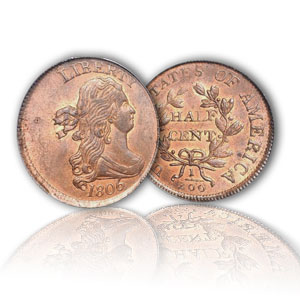
Designed by Robert Scot, the Draped Bust half cent replaced the Liberty Cap half cent of 1794-97. The new Draped Bust half cent featured a new type of Liberty bust on the obverse. This Miss Liberty wore a hair ribbon. She had a younger, more feminine look, with long flowing hair that curled gracefully down to her back. This bust was fuller beneath the neck with the top of the bust showing, though it was modestly covered by drapery. On the reverse was basically the same wreath and “Half Cent” within the wreath that had appeared on the earlier half cents of 1793 and 1794-97.
Though the Draped Bust half cent’s first year mintage of 211,530 clamor for. Just why DID the United States make half cent coins? It mainly had to do with the proliferation of Spanish-Colonial silver coins circulating in the
United States. True, the United States Mint was by this time striking her own silver coins, but obviously they weren’t making enough to go around. The American public still loved using Spanish and Spanish-Colonial silver. It was the Spanish-Colonial silver coins (struck in such places as Mexico, Peru, Bolivia, Chile, etc.) that prompted the need for a half cent. Consider: goods in the U.S were often priced in Spanish measurements—so while something priced at “two bits” (two reales) was the equivalent of twenty-five U.S. cents, something priced at “one bit” (one reale) would have to be paid for in the equivalent of 12 and ½ cents.pieces seems small to us now, it was actually a pretty healthy mintage for the time. Especially for a coin type that there was little public
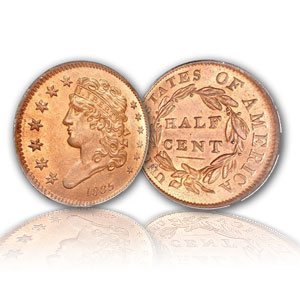
The Classic Head half cent of 1809-35 is the most commonly encountered of all the half cents. Like all half cents, this is a scarce coin type, but had the highest mintages of any U.S. half cent type. Actually the Braided Hair half cent of 1840-57 was struck over a longer period of time, but only in its final years of 1849-57 were any of them really struck for circulation. The Classic Head half cent is the only half cent to have a mintage of over 1 million in a single year—that being 1809. And that was the only year ANY half cent mintage reached 1 million.
The Liberty bust on the Classic Head half cent strongly resembles the Capped Bust liberty head on the U.S. silver coins of 1809-37. Still, there is enough difference to classify the Classic Head coppers and the Capped Bust silver coins as two different coin design types. As it is, the Classic Head half cent shared its design only with the Classic Head large cent. Both coins feature a husky, heavily-curled Miss Liberty (derided in her day as the “Blowsy Barmaid”) wearing a French type cap and headband reading “Liberty.” On the reverse, the coin denomination is spelled out within a wreath. The Capped Bust large cent made its debut in 1808.
At first, it seemed that the Classic Head large cent was destined to outlive the Classic Head half cent. After 1811, the Classic Head half cent vanished. Meanwhile, the Classic Head large cent kept on being struck through 1814, after which, it too disappeared. In 1815, no U.S. copper coins were struck, but when copper coinage resumed in 1816, it resumed in the form of a new large cent: the Coronet Head large cent. But as for the half cent, it was nowhere to be seen. Logic dictated that if the half cent was to return, it would be a Coronet Head half cent. But fourteen years passed without any new strikings of half cents.
Then, in 1825, the half cent made a comeback. But instead of a Coronet Head half cent to parallel the Coronet Head LARGE cent that had been in production for nine years, the U.S. Mint simply continued on with the Classic Head half cent design! In fact, strangely, while the Coronet Head large cent continued on through 1839, the Classic Head half cent was struck alongside it for nearly that long. The end for the Classic Head half cent finally came in 1835, though there was a proof-only striking in 1836. Why a Coronet Head half cent was never struck as a “sibling” to the large cent, it’s hard to say. Perhaps since the half-cent was not an all-important coin denomination by the 1820’s, the U.S. Mint may simply have elected to save money on creating new coin dies.
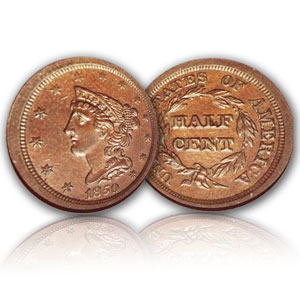
The Braided Hair half cent of 1840-57 is a strange U.S. coin type. In more ways than one.
The Braided Hair half cent is very much an “afterthought” coin. It’s definitely an afterthought to many collectors. It's easy to think of the half cent as mainly being an early U.S. coin of the late 1700’s and early 1800’s. Yet there is the Braided Hair half cent, struck for seventeen years in the mid-1800’s. Judging by the small mintages and ten-year clearing-its-throat period when it came to striking circulation issues, the Braided Hair half cent was clearly an afterthought to the United States Mint as well.
The Braided Hair half cent was the first U.S. half cent to be struck since the end of the Classic Head half cent in 1836. The design of the Braided Hair half cent was identical to that of its big sibling, the Braided Hair large cent of 1840-57. It was designed by Christian Gobrecht.
The Braided Hair half cent is actually a great deal scarcer than the earlier Classic Head half cent AND Draped Hair half cent. In fact, it actually rivals the Liberty Cap half cent in terms of mintage scarcity. From 1849 through 1857, only two dates, 1851 and 1853, have mintages above 56,000. Even so, the “common” 1851 and 1853 dates have mintages of only 147,672 and 129,694 respectively.